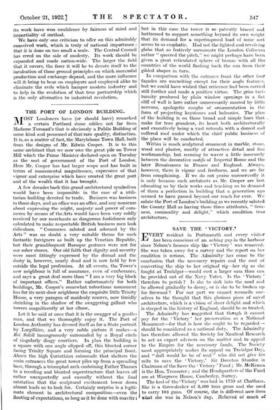THE PORT OF LONDON BUILDING.
it/rOST Londoners have (or should have) remarked -0-1- a certain. Portland stone edifice not far from -Madame Tussaud's,that is obviously a Public Building- of some. kind. and possessed 'of that rare quality, distinction. It is,i as, a matter of fact, theMarylebone Town Hall-built from the designs of Mr. Edwin Cooper. It is to this same' architect: that we now -owe the great pile on Tower Hill which the _Prime Minister • declared open on Tuesday as the seat of government of the Port of London, Here Mr. Cooper has had larger scope and has built- in terms of monumental magnificence, expressive of that vigour and enterprise which have created- the great port and of :the wealth that it has brought.
A few decadesbaek this- grand architectural synibolism would- have been impossible in the ease of a utili- tarian•building devoted to- trade. Business was business in those days, and an office was an office, and any-nonsense about expressing • the might, majesty. and 'power of com- merce by' means of the would have been very coldly received- by our merchants as dangerous foolishness only calculated: to make' respectable British businessmen look ridiculous. " Commerce saluted and adorned by the Arts." was no doubt a very . suitable theme for -such fantastic foreigners as built up the Venetian Republic, but their grandiloquent -Baroque gestures were not 'for our sober shores. Our old faith that dignity and- security were most fittingly expressed by the dismal and the dusty is, however, nearly dead and is now held by few outside the legal profession. At -all events, the Tower's new neighbour is full of assurance, even of exuberance, and says a great deal more- than "'I am a very big' block of important offices." Rather unfortunately for both buildings, Mr. Cooper's somewhat -robustious monument has for-its next-door neighbour the exquisite little Trinity Mouse, a very paragon- of maidenly reserve, now timidly shrinking in 'the shadow of the swaggering gallant who towers .magnificently at her elbow.
'Let it be said at once that it is the swagger of a gentle- man, and that we thoroughly enjoy 'it. The Port of London Authority has dressed itself as for a State portrait by Largilliere, and a very noble picture it makes—a Rol Soleil incongruously surrounded -by a . Royal circle of singularly dingy courtiers. In plan the building is a square with one angle clipped off, this 'blunted corner facing' Trinity Square and forming 'the principal front. Above the high Corinthian colonnade that shelters the main entrances the great tower piles up from a spreading base,-through El:triumphal arch.enshrining Father Thames to a receding and blunted superstructure that leaves off rather unexpectedly and casually without the final salutation that the sculptural excitement lower down almost leads us to look for. Certainly surprise is a legiti- mate element in architectural composition—even the flouting of expectations; so long as it be done with suavity; but in this case the tower is so patently braced and buttressed to •support something beyond its own weight that its demand for a superimposed load of some sort seems to us emphatic. Had not the lighted and, revolving globe that so festively surmounts the London Coliseum rather " queered the pitch," we might perhaps have been given a great reticulated sphere of bronze with all the countries of the world flashing back the sun from their gilded shapes in turn.
In comparison with the entrance front the other four facades are unexciting except for their angle features, but we could have wished that reticence had been carried still further and made a positive virtue. The grim taci- turnity produced by plain window openings in it flat cliff of .wall is 'here rather unnecessarily marred by little nervous, apologetic coughs of ornamentation in the form of projecting keystones and balconies. The plan of the building is on those broad and simple lines that _ make for true grandeur, its heart both architecturally and executively 'being a vast rotunda with a domed and coffered roof under which the chief public business of the place will be conducted.
Within is much sculptural ornament in marble, stone, wood and plaster, mostly of attractive detail and fine workmanship, but seeming to waver a little insecurely between the decorative motifs of Imperial 'Rome' and the later Renaissance in France and England. Always, however, there is vigour and freshness, and we are far from complaining. If we do not praise unreservedly it is only because such architects as Mr. Cooper are fast educating us by their works and teaching us to demand of them a perfection in building that a generation ago seemed to have passed beyond our reach for ever. We salute-the Port of 'London's. building as we recently saluted the- County Hall as having- those three attributes, " firm- ness, commodity and delight," which condition true architecture.


































































 Previous page
Previous page